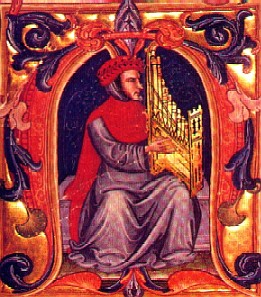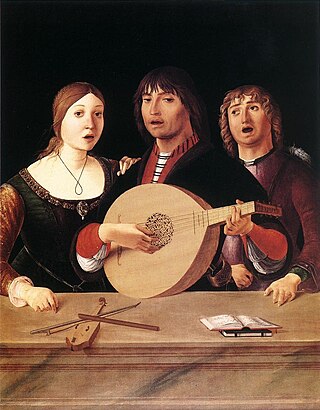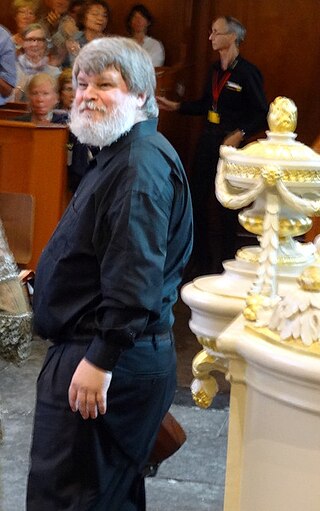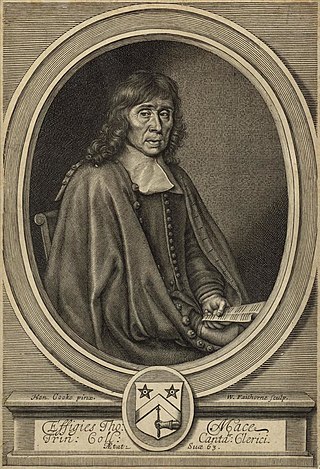Notes
- ↑ Spring, M. "Cuthbert Hely". Oxford University Press: New Grove Online.
- ↑ Spring, M. (2001). The Lute in Britain: a history of the instrument and its music. Oxford University Press. pp. 335–338.
Cuthbert Hely was an English lutenist and composer who was active during the first half of the 17th century. [1]
Nothing so far is known about his life. [2] It may be assumed, though, that Hely was taught to play the lute by musicians of John Dowland's generation. If so, Cuthbert Hely may have been born around 1570.
It was believed that Hely may have been Lord Herbert's lute teacher and that he was the compiler of Lord Herbert's lute book. Both these points seem unlikely, though, as Lord Herbert, by his own account, learned the lute around 1603 "with very little or no teaching," and Hely's contributions to Lord Herbert's lute book are only found in the hand of "Scribe C," whose entries are the latest in the manuscript, datable to 1639-1640.
It is uncertain if the composer is identical with a certain Cuthbert Hely who lived in Ludlow, England, during this era.
Eight compositions by Cuthbert Hely - four fantasias, three preludes, and a sarabande - are to be found in the lute book owned by Edward, Lord Herbert of Cherbury. Only one other work of Cuthbert Hely has been known so far, an air in four parts found in GB-Lbl Add.18940, a manuscript source dated to about 1650.
Although only a few works have survived, Cuthbert Hely's music is an example of 17th-century English lute music at its summit, attempting to bring Elizabethan "Golden Age" practices into the first phase of the Baroque era. His intensive and sometimes strongly melancholy style is carried over from the work of earlier composers such as John Dowland.

John Dowland was an English Renaissance composer, lutenist, and singer. He is best known today for his melancholy songs such as "Come, heavy sleep", "Come again", "Flow my tears", "I saw my Lady weepe", "Now o now I needs must part" and "In darkness let me dwell". His instrumental music has undergone a major revival, and with the 20th century's early music revival, has been a continuing source of repertoire for lutenists and classical guitarists.

A lute is any plucked string instrument with a neck and a deep round back enclosing a hollow cavity, usually with a sound hole or opening in the body. It may be either fretted or unfretted.

The viol, viola da gamba, or informally gamba, is any one of a family of bowed, fretted, and stringed instruments with hollow wooden bodies and pegboxes where the tension on the strings can be increased or decreased to adjust the pitch of each of the strings. Frets on the viol are usually made of gut, tied on the fingerboard around the instrument's neck, to enable the performer to stop the strings more cleanly. Frets improve consistency of intonation and lend the stopped notes a tone that better matches the open strings. Viols first appeared in Spain and Italy in the mid-to-late 15th century, and were most popular in the Renaissance and Baroque (1600–1750) periods. Early ancestors include the Arabic rebab and the medieval European vielle, but later, more direct possible ancestors include the Venetian viole and the 15th- and 16th-century Spanish vihuela, a six-course plucked instrument tuned like a lute that looked like but was quite distinct from the four-course guitar.

Edward Herbert, 1st Baron Herbert of Cherbury KB was an English soldier, diplomat, historian, poet and religious philosopher of the Kingdom of England.

Francesco Landini was an Italian composer, poet, organist, singer and instrument maker who was a central figure of the Trecento style in late Medieval music. One of the most revered composers of the second half of the 14th century, he was by far the most famous composer in Italy.
Thomas Robinson was an English Renaissance composer and music teacher, who flourished around 1600. He taught and wrote music for lute, cittern, orpharion, bandora, viol, and voice.

The term lute song is given to a music style from the late 16th century to early 17th century, late Renaissance to early Baroque, that was predominantly in England and France. Lute songs were generally in strophic form or verse repeating with a homophonic texture. The composition was written for a solo voice with an accompaniment, usually the lute. It was not uncommon for other forms of accompaniments such as bass viol or other string instruments, and could also be written for more voices. The composition could be performed either solo or with a small group of instruments.

Thomas Ford was an English composer, lutenist, viol player and poet.

A consort of instruments was a phrase used in England during the 16th and 17th centuries to indicate an instrumental ensemble. These could consist of the same or a variety of instruments. Consort music enjoyed considerable popularity at court and in the households of the wealthy in the Elizabethan era, and many pieces were written for consorts by the major composers of the period. In the Baroque era, consort music was absorbed into chamber music.
Robert Johnson was an English composer and lutenist of the late Tudor and early Jacobean eras. He is sometimes called "Robert Johnson II" to distinguish him from an earlier Scottish composer. Johnson worked with William Shakespeare providing music for some of his later plays.

During the reign of Queen Elizabeth I (1558–1603), English art and high culture reached a pinnacle known as the height of the English Renaissance. Elizabethan music experienced a shift in popularity from sacred to secular music and the rise of instrumental music. Professional musicians were employed by the Church of England, the nobility, and the rising middle-class.

The Trecento was a period of vigorous activity in Italy in the arts, including painting, architecture, literature, and music. The music of the Trecento paralleled the achievements in the other arts in many ways, for example, in pioneering new forms of expression, especially in secular song in the vernacular language, Italian. In these regards, the music of the Trecento may seem more to be a Renaissance phenomenon; however, the predominant musical language was more closely related to that of the late Middle Ages, and musicologists generally classify the Trecento as the end of the medieval era. Trecento means "three hundred" in Italian but is usually used to refer to the 1300s. However, the greatest flowering of music in the Trecento happened late in the century, and the period is usually extended to include music up to around 1420.

In English early Baroque music, a broken consort is an ensemble featuring instruments from more than one family, for example a group featuring both string and wind instruments. A consort consisting entirely of instruments of the same family, on the other hand, was referred to as a "whole consort", though this expression is not found until well into the seventeenth century. The word "consort", used in this way, is an earlier form of "concert", according to one opinion, while other sources hold the reverse: that it comes from the French term concert or its Italian parent term concerto, in its sixteenth-century sense. Matthew Locke published pieces for whole and broken consorts of two to six parts as late as 1672.

Paul Raymond O'Dette is an American lutenist, conductor, and musicologist specializing in early music.
"Flow, my tears" is a lute song by the accomplished lutenist and composer John Dowland (1563–1626). Originally composed as an instrumental under the name "Lachrimae pavane" in 1596, it is Dowland's most famous ayre, and became his signature song, literally as well as metaphorically: he would occasionally sign his name "Jo: dolandi de Lachrimae".
Francis Cutting (c.1550–1595/6) was an English lutenist and composer of the Renaissance period. He is best known for "Packington's Pound" and a variation of "Greensleeves" called "Divisions on Greensleeves", both pieces originally intended for the lute.

"My Lord Chamberlain, His Galliard " is a piece by John Dowland for the lute. It was printed in his First Booke of Songes or Ayres. The Lord Chamberlain at the time of publication was George Carey, 2nd Baron Hunsdon who with his wife Elizabeth was the dedicatee of the First Book.

The mandore is a musical instrument, a small member of the lute family, teardrop shaped, with four to six courses of gut strings and pitched in the treble range. Considered a French instrument, with much of the surviving music coming from France, it was used across "Northern Europe" including Germany and Scotland. Although it went out of style, the French instrument has been revived for use in classical music. The instrument's most commonly played relatives today are members of the mandolin family and the bandurria.

Early music of Britain and Ireland, from the earliest recorded times until the beginnings of the Baroque in the 17th century, was a diverse and rich culture, including sacred and secular music and ranging from the popular to the elite. Each of the major nations of England, Ireland, Scotland, and Wales retained unique forms of music and of instrumentation, but British music was highly influenced by continental developments, while British composers made an important contribution to many of the major movements in early music in Europe, including the polyphony of the Ars Nova and laid some of the foundations of later national and international classical music. Musicians from the British Isles also developed some distinctive forms of music, including Celtic chant, the Contenance Angloise, the rota, polyphonic votive antiphons, and the carol in the medieval era and English madrigals, lute ayres, and masques in the Renaissance era, which would lead to the development of English language opera at the height of the Baroque in the 18th century.

Thomas Mace was an English lutenist, viol player, singer, composer and musical theorist of the Baroque era. His book Musick's Monument (1676) provides a valuable description of 17th century musical practice.